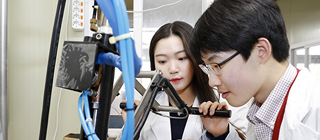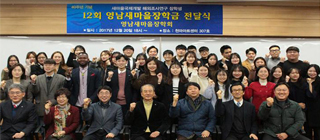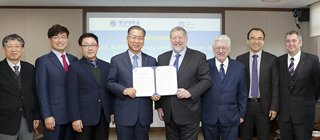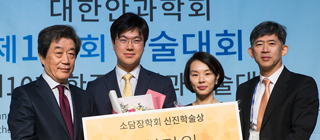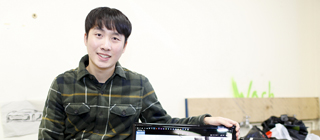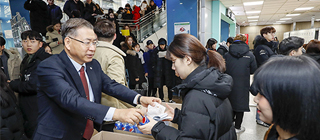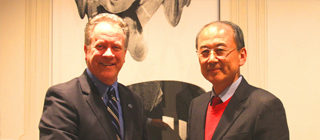-
Applied for patents using knowledge learned during class as sophomores and registered patent before graduating Developed ‘fusion device’ with improved productivity and economic feasibility that can produce high quality metals Can be used in research centers related to metal... Currently being used in undergraduate research labs [December 20, 2017] YU students developed a device using knowledge they learned in their major to register a patent. The patent that they registered is the ‘Fusion device (patent no. 10-1790431), and its inventors are registered as YU School of Materials Science and Engineering Professor Park No-geun (36), Baek Seung-min (26, graduated from YU School of Materials Science and Engineering), senior Shin Yoon-ji (22, left on photo), and Lee Dong-hee (22, right on photo). The patent was applied for in March of last year and recently registered and gained more interest as Shin Yoon-ji and Lee Dong-hee designed this based on what they learned in class as sophomores and registered the patents while still being enrolled in undergraduate school. The patent that they registered is a technology that suppresses oxidation reactions that occur in the melting and cooling process of metal materials. They applied what they learned in the ‘Material Equilibrium’ class (Advising Professor Park No-geun’, which is a major class of the School of Materials Science and Engineering, during the second term of 2015, The patent inventor Shin Yoon-ji said, “In existing fusion devices, there is a huge loss with a collection rate of only 60-65% when solidifying the melted materials during metal casting. The fusion device that we developed improved productivity by increasing the collection rate to about 80%. Furthermore, other melting equipment used expensive vacuum facilities to prevent oxidation of metals, but our patented technology can suppress oxidation reactions of metals while using relatively cheaper vacuum equipment, making it possible to produce less expensive, yet high quality metals.” <School of Materials Science and Engineering Senior Shin Yoon-ji and Lee Dong-hee is conducting research on the patented fusion device that they developed.> The patented technology can be used in metal-related research labs and it is expected to help improve metal properties testing and on research for enhancing metal functionalities. The patented device is currently being used for research and testing at the YU School of Materials Science and Engineering. Lee Dong-hee revealed his future research plans saying, “I want to participate in more in-depth research in the alloy design field by enrolling in graduate school.” Professor Park No-geun said, “The students showed great interest in their majors, and continuously worked on identifying and resolving pending issues as students of engineering, which led to the achievement of registering a patent while still in school.” He added, “Having intellectual property rights as an undergraduate student is a priceless experience. It will serve as an opportunity for them to do more in-depth research in their majors at graduate school.”
-
38 selected for ‘overseas studies scholarship students’ in commemoration of the 40th years since the founding of the Department of Saemaul and International Development 3 international students from Africa and Vietnam also selected for scholarships Scholarships given every since 2006 to give 180 million won to a total of 184 students [December 21, 2017] <The YU Saemaul Scholarship Association held the 12th Scholarship Ceremony on the 20th> The YU Saemaul Scholarship Association (Chairman Choi Wae-chul, Professor of the YU Department of Saemaul and International Development) held its 12th scholarship ceremony at the YU Cheonma Art Center on the 20th in commemoration of the 40th year anniversary of the department. The scholarship provided by the YU Saemaul Scholarship Association gave a total of 40 million won by selecting ‘foreign studies scholarship students’ to fit the characteristics of the department that fosters experts to solve global issues in commemoration of the 40th year anniversary of the YU Department of Saemaul and International Development. Students selected for scholarships will visit countries such as Vietnam, Myanmar, Singapore, Indonesia, Laos, Thailand, Cambodia, China, Japan, England, Germany and France to examine and research the development cooperation cases of international organizations as well as the policy cases for the development of emerging nations. There were a total of 38 students selected for scholarships in 2017 from nine teams including the ‘Do You Love Saemaul’ team. The selected scholarship students included international students who came to study at the Department of Saemaul and International Development. Chimereze Eden Nwaogu (bottom photo – left), a sophomore who came to study at YU from Gabon, Africa and Le Ngoc Tram and Le Khanh Nhat who are juniors from Vietnam make up the three international students. The overseas studies scholarship students selected will write a report after completing their overseas studies and share their research results with each other. Park Sae-woong, a sophomore in the School of Economics and Finance, who participated as an affiliate major to practice diligence, independence, cooperation and sharing, volunteering, and a creative spirit, was also selected for the scholarship. The YU Saemaul Scholarship Association was founded by alumni who studied in the Department of Local Social Development of YU that was founded in 1976 to support their juniors in their studies. The Association was organized in 2003 through the efforts of Chairman Choi Wae-chul, who was the first student in this department, and other graduates. Scholarships are being given every year since 2006 and a total of 182 million won was provided as scholarships to 184 students up until this year. At this ceremony, Chairman Choi Wae-chul said, “I am very happy that our association that aims at returning the scholarships that we received as students to other students is able to give scholarships for the 12th time, and I would like to thank everybody for their support.” He added, “It is now time to focus not only on the development of Korea, but also the international community who funded Korea with 12.77 billion dollars in the past. I hope that students of the Department of Saemaul and International Development will gain more capacities to become experts for solving common global issues to repay the international community, pioneer new paths for the future generation, encourage younger students, and contribute to social development.” YU College of Political Science and Public Administration Dean Kim Jung-hoon, Gyeongbuk Sports Association for the Disabled Secretary-general Kim Jung-il (former Vice-mayor of Sangju), Daegu Women and Family Policy Officer Ha Young-sook, YU Saemaul Scholarship Association Secretary-general Lee Gyeong-seop, Palgong MNC CEO Kim Jing-young, Professors Kang Dong-pil, Lee Jung-joo and Lee Mi-sook, and other alumni currently working different parts of society attended the ceremony to encourage junior students. Meanwhile, the YU Department of Saemaul and International Development graduated a total of 1,757 students up until now. The Saemaul Undong, which was registered as a world heritage by UNESCO, was organized as Saemaul studies and has been receiving attention as a department that fosters human resources who will address overcoming poverty and local development issues, who are joint challenges of the international community. In particular, the Department of Saemaul and International Development has been evaluated as a core department that exports Korea’s unique studies such as establishing the Department of Saemaul and Economic Development at Enderun University in the Philippines.
-
Agreed on student, professor and research exchange and joint research in the carbon fiber industry Planning to expand exchange to various fields such as join diploma programs Synergy effect expected by constructing a government-academic-research-industrial cluster through the establishment of the Gyeongsan AMRC Asia Hub Center [December 13, 2017] <On the 13th, YU and the University of Sheffield of England signed an international academic exchange MOU.> (From fourth on left, YU President Sur Gil-soo and AMRC Chairman Keith Ridgway) YU (President Sur Gil-soo) and The University of Sheffield signed an academic exchange MOU. The University of Sheffield is a prestigious national university of England located in Sheffield, South Yorkshire County. With this MOU, the two institutes agreed on exchange of undergraduate and graduate school students, professors and researchers, as well as international joint research. At the MOU signing ceremony held at the YU President’s Reception Room at 2 p.m. on the 13th, YU President Sur Gil-soo, Department of Fiber System Engineering Dean Kim Sam-soo, Professor Lee Jae-woong, and External Cooperation Office Director Lee Hee-wook, while AMRC (Advanced Manufacturing Research Centre) Keith Ridgway, Vice President John Baragwanath, Center Director Richard Scaife, and AMRC Korea Director Lee Jung-hwan representing the University of Sheffield, and Gyeongsan Vice Mayor Kim Ho-jin, and the US Embassy in Korea Science Technology Team Leader Gareth Davies attended the event. YU President Sur Gil-soo said, “By signing an academic exchange agreement with the University of Sheffield that graduated multiple Nobel Prize winners, our two universities now have the foothold to gain world-class research capacities.” He added, “Starting with personnel exchange and joint research related to the carbon fiber industry, we hope to expand our exchange to other fields as well.” Chairman Keith Ridgway replied, “As AMRC is pursuing the construction of a research center with local authorities such as Gyeongsan City and discussing plans to construct infrastructure related to the carbon fiber industry, we hope that exchange with YU will be pursued successfully. We hope for broad-ranged academic exchange with the university such as in operating joint diploma programs. AMRC (Advanced Manufacturing Research Centre) is an advanced manufacturing technology research institute co-founded by the University of Sheffield and Boeing in 2001. Over 100 member companies around the world including Rolls Royce are currently participating in joint R&D of products such as the carbon fiber industry. AMRC is planning to build the Asia Hub Center in Gyeongsan for the first time overseas. AMRC is pursuing the carbon fiber industry development project together with local governments such as Gyeongsan and local companies, and through this exchange with YU, it is expected to gain synergy effect through its global government-academic-research-industrial cluster.
-
-
YU Department of Industrial Design Lee Gi-taek introduced with Korean surrealism photo [December 11, 2017] <Department of Industrial Design Junior Lee Gi-taek who works as a surrealism artist> A man brushes his teeth in the bathroom. Another ego of this man appears in the mirror and pours mouth wash for him. The artwork, ‘Bathroom’ (photo below) was created by Lee Gi-taek (24), a junior at the YU Department of Industrial Design. Mr. Lee took the photo and edited it to express ‘another me helping me after a long day’. This piece will be published as a Korean surrealism artwork in a high school art textbook next year by Jihaksa Publishing Company. This is stirring up big news as there are very few cases in which a student’s artwork was carried by a textbook. Mr. Lee is already famous on social media platforms as a surrealism artist. He took on a different path from his major that mainly designs products. He said, “Three years ago, I decided to draw while serving in the military for self-development and so I began drawing with colored pencils whenever I had time. At the time, I usually drew hyper-realism pieces to look like photographs and I drew pictures in magazines or scenery from the military. But I thought that it was pointless to draw something exactly the way it looked so I decided to add my thoughts in it. I began adding elements that could not exist in reality." He uploaded his drawings on his social media account whenever he was on leave. It was for fun, but visitors to his account called his works surrealism. He would draw shoes as if it were real and express the laces with fingers, or combined hands and a necktie on top of a dog’s head as part of his unique artwork, and visitors to his page gradually began to grow. Lee’s social media account became more popular as both the general public and other artists began to visit his site. He studied about surrealism on his own and one day learned about the artwork of the Swedish surrealism artist Erik Johansson, and from then on, he decided to express surrealism no longer from drawings, but with photos. <Bathroom (Digital camera photo / Variable size / Lee Gi-taek, 2015> After being discharged from the military, he began to take photos of everyday life and use Photoshop to create unique works and continued to upload them on social media account. The number of visitors continued to grow and he now has over 17,000 followers. Lee’s work caught the attention of a textbook publisher who saw his work and the publisher contacted Lee through his social media account and after a year of review, it was confirmed to carry his work in the textbook. Though it started just as a hobby, he continuously uploaded his work and after a while, his social media followers gave him the title ‘artist’. Thanks to this, the Korean Artists Welfare Foundation officially recognized him as an artist in February of last year, and he is now active as an official artist. He also holds various exhibits. Seoul COEX suggested that he hold an exhibit and so he held an exhibit once last year and once this year. Last year, he took a leave-of-absence from school to concentrate on artwork and he leased a small studio in Seoul and has been holding art exhibits in Shinchon and other areas. He returned to school this year and is currently working on his school as well as his artwork simultaneously. “When people ask me about surrealism, I say that it is child-like imagination. I show them my works and tell them let their imagination carry them away. Many professional artists say that my works are ‘B-grade sentiments’, but my ideas are interesting. My classmates used to tease me saying that I was an ‘attention monger’, but now they say that they want to be a part of my works and respect my works.” He hopes to become a professional artist after graduating. Lee said, “I currently work mainly with photographs, but I plan to produce videos and integrate design,” and added, “I want my works to be shared not only in Korea, but abroad as well.”
-
YU President Sur Gil-soo delivers ‘A+ Snacks’ on the morning of the first final exams for the second semester Worked with the Student Government to share hand-made hamburgers and beverages to encourage students [December 12, 2017] <YU President Sur Gil-soo, professors and students of the student government share snacks on the morning of the first day of the finals.> At 8 a.m. on the 12th, the first day of the 2017 second semester finals, students lined up at the library early in the morning to go to the 1st floor lobby of the YU Central Library. YU President Sur Gil-soo, professors and the student government teamed up to deliver morning snacks for students who skipped breakfast to come to school early and study for their tests. <Student government president Park Sung-min (right) shares snacks with students.> Wie Gyu-ho (19, Department of Mathematics Education, Freshman), who lined up early in the morning and was the first to receive the snack, said, “I saw an announcement on the student government Facebook page that said they would give free snacks this morning, so I got in line early.” He added, “I received a snack from the president of the university on the first day of the examinations so I think that I will have good luck in the tests.” Kang In-wook (19, Department of Mathematics Education, Freshman) said, “I stayed up all night at the library to study for my exams. I hope that many students get their free snack and do well on the finals.” The snack delivery was made simultaneously at the YU Central Library basement lobby and Science Library first floor. Hand-made burgers and beverages were prepared for a total of 800 people, but it was so popular that all of them were handed out in just 10 minutes. YU President Sur Gil-soo said, “I am proud of the students who skipped breakfast to come to school early despite the cold weather to study for their tests. I want the students to know that the professors including myself, and other school colleagues are supporting you.” He further added, “I hope you all do well at the finals and end 2017 on a high note.”
-
YU students to participate in WFP internship… ‘Fostering international organization experts’ Department of Saemaul and International Development Professor Choi Wae-chul meets with WFP Secretary-General David Beasely for discussions [November 24, 2017] <YU decided to work together with the UN WFP to lead the eradication of global poverty and hunger by fostering experts.> (Department of Saemaul and International Development Professor Choi Wae-chul (right) and WFP Secretary-General David Beasley) YU agreed to work with the UN WFP (United Nations World Food Programme (hereinafter ‘WFP’) to take the initiative for eradicating global poverty and hunger. By sharing Korea’s development experience and know-how with the WFP and having YU students participate in the WFP internship program, the two institutes agreed to foster international organization experts. In order to discuss details, YU Department of Saemaul and International Development Professor Choi Wae-chul met with WFP Secretary-General David Beasely at the global hunger-eradication event, ‘Towards Zero Hunger’ hosted by the WFP on November 22. Mr. Beasely showed interest on the remarkable growth of Korea achieved in a short period of time and asked many questions as soon as he met with Professor Choi. When asked how Korea was able to overcome poverty in such a short period of time, Professor Choi said, “At the time, Korea pursued reforms in thinking, environmental reforms, and plans to increase income simultaneously.” Mr. Choi further explained about the trust between the public and leaders, consensus and participation of the people, consistent policies, sharing success and failure cases, dedication of leaders, and fostering of human resources. Mr. Beasely also asked to introduce the methods that were actually put into place to prevent corruption, which Mr. Choi answered with the method of delivering support materials to community members during the Saemaul Undong, which Mr. Beasely showed great interest in. Professor Choi also stated, “I am very thankful for the support that the WFP gave for Korea to overcome its state of absolute poverty since 1964. Our university is also making various efforts to repay the help received from the WFP and the international community in the past. I am certain that the Saemaul International Development human resources being fostered by YU will contribute to achieving the ‘zero hunger’ goal set by the international community.” He added, “There are currently YU graduates working at WFP offices in emerging nations. Please allow more YU students to gain practical experience at the WFP through the internship.” Mr. Beasely responded, “I fully agree to the internship proposal” and added, “It is now time for Korea, as an ODA contributor, to provide assertive support for emerging nations facing difficulties to due poverty.” WFP was founded in 1961 and is a UN institute that is leading the eradication of poverty and hunger in over 80 nations as of current. ‘Zero Hunger’ being pursued by the WFP is part of the efforts to make a world without hunger, which is the second sustainable development goal by 2030 being pursued by the international community. WFP is working with Korea’s Ministry of Foreign Affairs and KOICA on the Zero Hunger Community project by adopting the Saemaul Undong model in four nations including Rwanda and Nepal since 2011. Meanwhile, the WFP funded 104,463,511 USD for the overcoming of poverty in Korea for 20 years from 1964 to 1984. There were 23 projects pursued in Korea including food, flood control and day care centers, and the WFP project pursued in Korea was assessed to be a successful case by the international community. WFP signed an agreement with the Korean government in February 2015 to engage in projects to overcome poverty and improve the quality of life in over 30 nations every year.
-
Royal family of Thailand recognizes contributions to the development of forestry in the ASEAN region Served as director of the Korea Forest Service and chairman of the International Union of Forest Research Organizations and played a huge role as an international scholar on forestry Fostering students by teaching international students from emerging nations as a chair professor at the Park Chung Hee School of Policy and Saemaul [November 30, 2017] <Park Chung Hee School of Policy and Saemaul Chair Professor Lee Don-gu received an honorary doctorate’s degree at the Kasetsart University of Thailand for his contributions to the development of the forestry industry.> (From left to right: Chair Professor Lee Don-gu, Kasetsart University President Chongrak Wachrinrat) YU Park Chung Hee School of Policy and Saemaul Chair Professor Lee Don-gu (71, former director of the Korea Forest Service) received an honorary doctorate’s degree from Kasetsart University in Thailand for his contributions to the development of the forestry industry on the 25th of last month. Kasetsart University, which is a prestigious national university of Thailand, was established in 1943 and has seven campuses including one in Bangkok with over 45,000 students enrolled, being one of the biggest universities of Thailand. Chair Professor Lee Don-gu led education/research training for 12 years (2000-2011) as the project supervisor of Kasetsart University in the Korea-ACEAN environment cooperation project (AKECOP) and was recognized for his contributions to the development of forestry in the ASEAN region. Korea has been fostering ASEAN regional experts through AKECOP from 2000. <Princess of Thailand Chulabhorn Walailak gives YU Park Chung Hee School of Policy and Saemaul Chair Professor Lee Don-gu an honorary doctorate’s degree.> Chair Professor Lee Don-gu served as the director of the Korea Forest Service, chairman of the International Union of Forest Research Organizations, and chair of the UN Convention to Combat Desertification (UNCDD), playing a big role as an international scholar on forestry. Professor Lee is judged to have contributed greatly in the development and dissemination of domestic forest sciences through his abundant research experience and international relations. Professor Lee majored in forest sciences at Seoul National University and focused only on forestry for over 40 years. He is currently serving as a chair professor at the YU Park Chung Hee School of Policy and Saemaul to pass on the success experiences and knowledge of Korea’s forestry and greenification to international students from emerging countries through lectures on afforestation and forest ecologies.
-
Use of printing technologies, low cost and very easy... Crystal-type electronic materials real-time directing printing technology Can be applied in flexible electronic devices such as smart displays and biosensors Published in world-acclaimed academic journal in the physics and chemistry sector [December 1, 2017] <YU School of Chemical Engineering Professor Kim Se-hyun (left) and Bae Jae-hyun who developed the crystal-type electronic materials direct printing technology applying flexible electronic devices> YU School of Chemical Engineering Professor Kim Se-hyun’s research team (major in polymers and bio materials) developed the crystal-type electronic materials direct printing technology that can be applied to flexible electronic devices. Crystallization and pattern-forming technologies for electronic materials in the past had multiple and complex procedures. The real-time direct printing technology that Professor Kim’s research team developed is a very simple technology that can control the crystallization orientation and patterns of electronic materials at low costs. . <Crystal-type electronic device printing technology developed by Professor Kim’s research team in action> The printing technology of ink-jet printers commonly used today discharge ink through external pressure. Compared to this, the technology developed by Professor Kim’s research team applies an electric field between the nozzle and substrate to improve the crystal orientation of electronic material molecules, while forming patterns through the movement of the nozzle. <Crystallization orientation and patterns of electronic material molecules produced with the crystal-type electronic materials direct printing technology> Professor Kim who led this research explained, “Because the crystallization direction and formation process are determined through the electric field and nozzle direction, very simple and large-area crystallization control is possible.” He added, “The technology developed here is expected to be applied in various flexible electronic devices. In addition to the transistor shown in this study, the technology was applied in smart window displays for which colors change depending on the electric field, and bio sensors as well, and we are planning to expand the fields of application through follow-up research.” The research results were published in the latest issue of the world-acclaimed academic journal in physical chemistry, <Journal of Physical Chemistry Letters> (impact factor (IF) 9.353). This research was joined by Bae Jae-hyun (YU Graduate School of Advanced Organic Materials Engineering master’s degree graduate, current senior researcher at LG Display) as the first author and Professor Kim Se-hyun as the corresponding author.
-
Tracking the traces of the Joseon Tongshinsa (Korean delegation) in Hiroshima and engaging in peace activities Japanese press coverage Pursuing programs for understanding the history and culture of Korea and Japan, presenting Korea-Japan exchange model [November 22, 2017] <YU Department of Japanese Language & Literature students visited Hiroshima as the ‘21st Century Joseon Tongshinsa’. (Hiroshima Peace Park Nuclear Blast Dome)> YU students visited Japan and acted as the ‘21st Century Joseon Tongshinsa (Korean delegation)’. Twenty students in the YU Department of Japanese Language & Literature visited Hiroshima, Japan from November 5 to 11 and made field trips and took part in exchange activities based on the theme of ‘Joseon Tongshinsa and Peace’ together with students from the Hiroshima University of Economics, which is a sister university. During this program, students from the two universities were invited to the ‘Congratulatory Banquet for the Registration of the Joseon Tongshinsa Records as a UNESCO World Cultural Heritage’ and pledged to act as bridges for the peace between Korea and Japan as the ‘21st Century Joseon Tongshinsa’. On the eve of the event, the students visited the Tomonoura region of Hiroshima Prefecture, which was said to be always visited by the Joseon delegation in the past, to examine the records and traces left by the delegates. In addition, as this year marks the 20th year since Daegu and Hiroshima becoming sister cities, the students of the two universities discussed the topic of ‘Thinking of Korea-Japan Peace in Daegu and Hiroshima’ to rekindle the meaning of peace. Such activities of the YU Department of Japanese Language & Literature received attention from the Japanese press as well. The biggest local press company of Hiroshima, ‘Chukoku Newspaper’ introduced the activities of YU students on its November 11 issue (article and photo on right). The YU Department of Japanese Language & Literature has been offering local learning activities for students through annual Japanese culture visit programs as well as Korea-Japan exchange activities by visiting Hiroshima, the sister city of Daegu from 2015. In November of last year, students visited Hiroshima and met with Former Hiroshima Mayor Hiraoka Takashi and those who experienced the nuclear bomb in Hiroshima in 1945 to share the true face of war and historical incidents to learn about the meaning of peace. Also, the ‘Korea-Japan joint exploration project’ was pursued together with students of the Hiroshima University of Economics as students traveled back and forth Korea and Japan in August to track the traces of the Joseon Tongshinsa and explore the modern history and culture of Korea and Japan. Recently, they participated in the planning of events related to the Joseon Tongshinsa hosted by Yeongcheon City, which was a base point for the Joseon Tongshinsa, as they worked as 21st Century Joseon Tongshinsa in both Korea and Japan. YU Department of Japanese Language & Literature Professor Choi Beom-soon said, “In this meaningful year celebrating the 20th year anniversary of sisterhood relations between Daegu and Hiroshima, students of the two countries discussed the meaning of peace and engaged in exchange activities to be able to understand each other’s history and culture.” He added, “Daegu and Hiroshima have a lot of history and culture that can be shared such as the history of the Joseon Tongshinsa and the issue of nuclear bombing damages. I hope that the various programs and activities pursued by the YU Department of Japanese Language & Literature will be an opportunity to suggest a new exchange model between Korea and Japan.” <Hiroshima Peace Park, Korean Memorial Stone>
